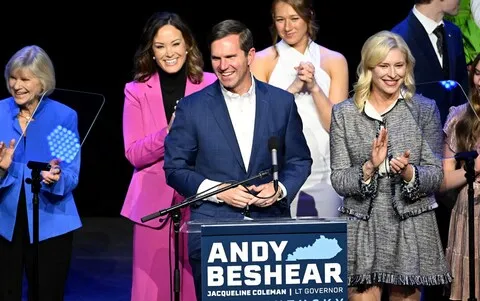The election returns on Tuesday demonstrated that the success of Republicans in overturning a constitutional right to abortion continues to be a very costly victory.
In Kentucky, a solidly red state, Democratic Gov. Andy Beshear sailed to a second term after a campaign that focused front and center on abortion rights.
In Ohio, an increasingly reliable Republican state, voters by double digits approved an amendment enshrining access to abortion in the state constitution. That was a rebuke to Gov. Mike DeWine and the GOP-controlled legislature, which had imposed a six-week ban as soon as the Supreme Court decision made that possible.
And in Virginia, GOP Gov. Glenn Youngkin had vowed to curb abortion if Republicans gained unified control of the state legislature. The GOP failed to flip the state senate − a result that cost Youngkin a potential springboard to national ambitions.
Sound familiar? Last year, in midterm elections held about four months after the high court’s landmark Dobbs decision, Republicans failed to score the “red wave” many expected.
They gained control of the House of Representatives, but by a margin so narrow that governing has proved fraught. Witness the looming government shutdown in little more than a week.
The Presidential Race
The power of the abortion issue to engage key voters, among them suburban women, and to energize turnout shows no signs of abating, and that is good news for President Joe Biden, now seeking a second term.
He was poised to embrace the referendum victory in Ohio as soon as the TV networks projected it had passed.
“Across the country tonight, democracy won and MAGA lost,” he declared in a tweet on the social media platform known as X that included a bid for campaign contributions. “Voters vote. Polls don’t. Now let’s go win next year.” In a written statement released by the White House, he decried what he called the “extreme and dangerous agenda” on abortion of MAGA Republicans − a reference to core supporters of GOP frontrunner Donald Trump.
Trump appointed the three Supreme Court justices who made overturning Roe v. Wade a reality, a point Team Biden already presses. Trump now approaches the issue gingerly, calling Florida’s six-week abortion ban a “mistake” and saying he wouldn’t support enacting a federal limit on the procedure.
But efforts to offer a more moderate tone on abortion didn’t work for Youngkin. He had fashioned what he characterized as a consensus position, proposing a ban at 15 weeks with exceptions in cases of rape and incest. “Reasonable limits,” he called them.
As the first returns were coming in, he seemed to recognize that the effort hadn’t turned the handful of crucial legislative contests. Abortion is “one of the toughest issues in Virginia and one of the toughest issues in the country,” Youngkin said when CNN anchor Dana Bash asked him about it, then instantly pivoted to talk about the economy.
Sure, here is the article you requested:
If he had succeeded, it surely would have fueled the efforts by some Republican donors urging Youngkin to jump into the presidential race, though some 2024 primary filing deadlines have already passed.
“Clearance Sale: All Youngkin for President 2024 merchandise,” Larry Sabato, a University of Virginia professor and longtime expert in the commonwealth’s politics, tweeted sarcastically. “No Returns.”
One lesson for Democrats down the ballot: Biden who?
To be honest, the off-year elections didn’t do much to illuminate next year’s battle for the White House. Democrats generally had a good night, but it didn’t calm concerns about Biden’s age and job approval.
Those fears were reinforced by a new national CNN poll that showed Biden trailing Trump 45%-49% among registered voters. Trump showed major gains among Blacks, Hispanics and younger voters, all important parts of Biden’s 2020 coalition. Biden’s approval rating was 41%.
Beshear’s win demonstrated that Biden’s political problems don’t necessarily drag down other Democratic candidates, even in states Trump carried.
But Beshear didn’t win in Kentucky by embracing Biden. He ignored him.
In contrast, Republican nominee Daniel Cameron ran ads featuring his endorsement by Trump.
In Beshear’s most powerful ad, a woman named Hadley described her experiences being raped by her stepfather, then castigated Cameron for the state law, passed over Beshear’s veto, that banned abortion even in cases of rape and incest. (Cameron then announced he would sign legislation allowing exceptions for rape and incest.)
In his victory speech in Louisville, Beshear talked about the meat-and-potato issues of building roads, recovering from floods, and offering universal pre-kindergarten. He didn’t mention the word “abortion,” but he expressed gratitude to Hadley as she stood toward the front of the audience, “who because of her courage this commonwealth is going to be a better place.”
Off-year elections aren’t reliable predictors about what will happen a year later. They’re a snapshot of the moment, but the picture that emerges is scattered with clues about what is moving voters and driving politics. And the races are called when there’s still time for candidates, political parties and activists to tweak a message or rethink a strategy.
The early returns underscored how closely divided the nation remains. As in a string of recent elections, the change of a few thousand votes in a handful of states could tip the balance across the government, in the White House, the House of Representatives and the Senate.





